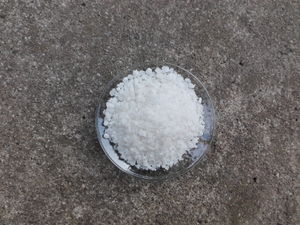Aluminium sulfate
 Lab-grade crystals of aluminium sulfate
| |
| Names | |
|---|---|
| IUPAC name
Aluminium sulfate
| |
| Systematic IUPAC name
Aluminium sulfate | |
| Other names
Aluminium sulphate
Alunogenite Cake alum Dialuminum sulfate Filter alum Papermaker's alum Vitriol of argile Vitriol of clay | |
| Identifiers | |
| Jmol-3D images | Image |
| |
| Properties | |
| Al2(SO4)3 | |
| Molar mass | 342.15 g/mol (anhydrous) 666.42 g/mol (octadecahydrate) |
| Appearance | White hygroscopic solid |
| Odor | Odorless |
| Density | 2.672 g/cm3 (anhydrous) 1.62 g/cm3 (octadecahydrate) |
| Melting point | 770 °C (1,420 °F; 1,040 K) (anhydrous); decomposes 86.5°C (octadecahydrate) |
| Boiling point | Decomposes |
| 31.2 g/100 mL (0 °C) 36.4 g/100 mL (20 °C) 89.0 g/100 mL (100 °C) | |
| Solubility | Insoluble in organic solvents |
| Acidity (pKa) | 3.3-3.6 |
| Thermochemistry | |
| Std enthalpy of
formation (ΔfH |
-3440 kJ/mol |
| Hazards | |
| Safety data sheet | ScienceLab |
| Flash point | Non-flammable |
| Related compounds | |
| Related compounds
|
Aluminium sulfide |
| Except where otherwise noted, data are given for materials in their standard state (at 25 °C [77 °F], 100 kPa). | |
| Infobox references | |
Aluminium sulfate is a chemical compound with the formula Al2(SO4)3, used mostly as a flocculating agent in the purification of drinking water or to reduce the pH of garden soil.
Contents
[hide]Properties
Chemical
When aluminium sulfate reacts with an alkaline hydroxide, such as sodium hydroxide, aluminium hydroxide precipitates:
- Al2(SO4)3 + 3 NaOH → 2 Al(OH)3 + 3/2 Na2SO4
Alumnium sulfate decomposes when heated to 770 °C, to release sulfur trioxide vapors and leave behind alumina:
- Al2(SO4)3 → Al2O3 + SO3
Aluminium sulfate slowly hydrolyzes in water to release diluted sulfuric acid.
Physical
Aluminium sulfate is an odorless, white hygroscopic crystalline compound, moderately soluble in water and insoluble in organic solvents. It has an acidic taste.
Aluminium sulfate is rarely encountered in the anhydrous form. Aluminium sulfate forms a number of different hydrates, the most common ones being the hexadecahydrate Al2(SO4)3·16H2O and octadecahydrate Al2(SO4)3·18H2O. A rarer form, the heptadecahydrate, written as [Al(H2O)6]2(SO4)3·5H2O, occurs naturally as the mineral alunogen.
Availability
Aluminium sulfate can be bought from various swimming pool and various home-improvement and gardening retailer stores, as flocculant tablets. The tablet always consists of the hydrated form.
Anhydrous or hydrated aluminium sulfate can be purchased from various chemical suppliers.
Preparation
Aluminium sulfate can be made by reacting sulfuric acid with aluminium oxide, hydroxide, halide or with hot aluminium metal.
- 2 Al(OH)3 + 3 H2SO4 → Al2(SO4)3 + 6 H2O
- 2 Al + 3 H2SO4 → Al2(SO4)3 + 3 H2
Projects
- Make alum
- Make aluminium nitrate
- Make aluminium hydroxide and oxide
Handling
Safety
Aluminium sulfate has low toxicity compared to other compounds, but it may cause aluminium poisoning if ingested in large quantities. The salt is considered to be toxic to the reproductive system. The anhydrous form is irritant on skin and eye contact, and may irritate the lungs if inhaled. If released in the environment in large quantities, it will raise the level of aluminium in the soil as well as the soil acidity.
Aluminium sulfate slowly hydrolyzes in water to yield sulfuric acid which is highly corrosive. In one notorious case, a large amount of aluminium sulfate (20 tonnes) was accidentally dissolved in the Camelford water supply and the resulting sulfuric acid dissolved lead and copper from the city plumbing, causing short-term mass poisoning.
Storage
Anhydrous aluminium sulfate must be stored in airtight containers, while the hydrated forms can be stored in any container, just keep it away from moisture.
Disposal
Aluminium sulfate can be safely poured down the drain, though it's best to heavily dilute it first, to prevent a build-up of sulfuric acid.
Gallery
References
Relevant Sciencemadness threads
- Chemical pages without CAS Registry Number
- Articles without EBI source
- Chemical pages without ChemSpiderID
- Chemical pages without DrugBank identifier
- Articles without KEGG source
- Articles without InChI source
- Articles without UNII source
- Articles containing unverified chemical infoboxes
- Chemical compounds
- Inorganic compounds
- Aluminium compounds
- Sulfates
- Materials unstable in basic solution
- Easily prepared chemicals
- Readily available chemicals
- Hygroscopic compounds
- Solids
